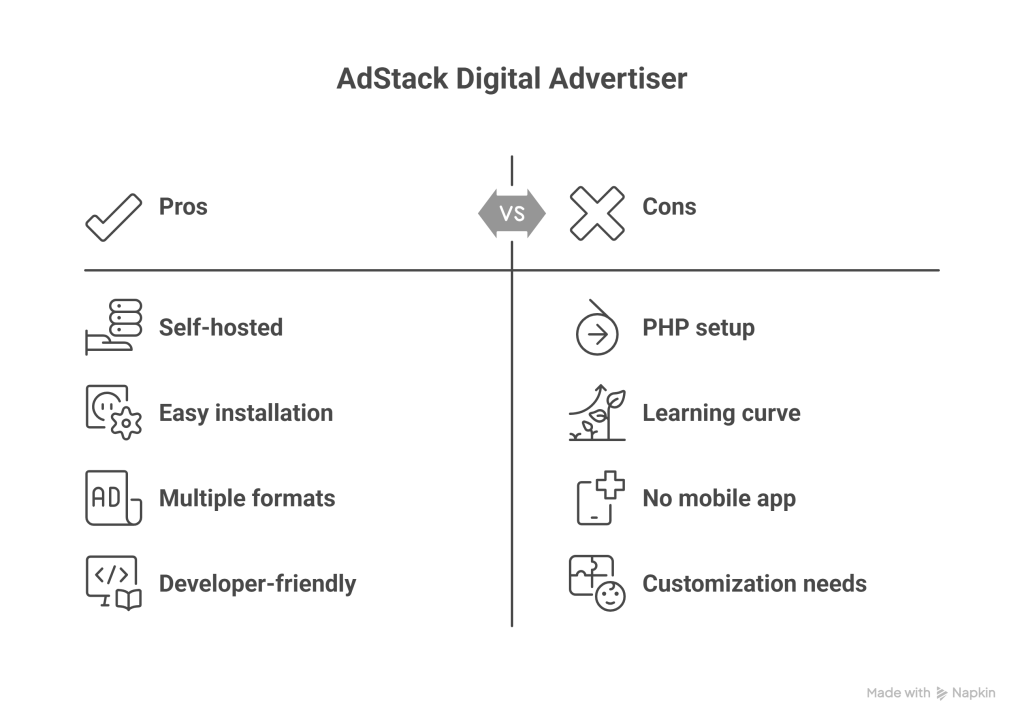Contents
Summary
AdStack Digital Advertiser is a powerful PHP ad management script for publishers, agencies, or SaaS founders. With advanced targeting, reporting, and monetization tools, it’s perfect for running your own ad network. Easy setup, clean code, and flexible licenses make it one of CodeCanyon’s best ad server scripts. 👉 Check it out here.
What Is AdStack Digital Advertiser?
AdStack Digital Advertiser is a PHP-based ad management platform that lets you run your own advertising server or network. It gives publishers, agencies, or SaaS founders a ready-to-deploy solution for managing, displaying, and tracking digital ads.
You can use AdStack to serve banner ads, video ads, or custom campaigns on your websites or for your clients. It’s built for developers, freelancers, and startups who want more control over ad revenue without relying on third-party ad networks.
👉 View AdStack Digital Advertiser on CodeCanyon
Key Features of AdStack Digital Advertiser
-
Full-featured ad server script for self-hosted ad delivery
-
Advanced targeting by device, location, and audience
-
Real-time reporting and analytics dashboard
-
Multiple ad formats (banners, videos, custom)
-
Advertiser and publisher account management
-
Secure payment gateway integration
-
Clean, modern admin panel
-
Multi-language support
-
Well-documented codebase for customization

Pros and Cons
| Pros | Cons |
|---|---|
| Complete self-hosted ad server | Requires PHP server setup |
| Easy to install and manage | Learning curve for advanced settings |
| Advanced targeting and reporting | No mobile app out of the box |
| Supports multiple ad formats | May need developer for heavy customization |
| Developer-friendly documentation |
Installation and Setup Guide
Setting up AdStack Digital Advertiser is quick and developer-friendly:
-
Download the script from CodeCanyon.
-
Upload all files to your hosting server.
-
Create a MySQL database and user.
-
Import the provided SQL file.
-
Update database details in
config.php. -
Follow the installation wizard in your browser.
Requirements:
-
PHP 7.4+
-
MySQL or MariaDB
-
cPanel or any web hosting with PHP & MySQL support
👉 The script includes detailed installation instructions in the documentation provided in the download.
Pricing and License Options
| License Type | Price | Usage Rights |
|---|---|---|
| Regular License | $XX | Use for one client or personal project |
| Extended License | $XX | Use in a SaaS product or charge end-users |
👉 Buy AdStack Digital Advertiser on CodeCanyon
Final Verdict – Is It Worth Buying?
AdStack Digital Advertiser is an excellent choice if you want a SaaS-ready PHP ad server to control your ad inventory and revenue. It’s affordable compared to custom development and gives you all the tools to run ads effectively.
Who should buy it:
-
Developers building custom ad solutions
-
Publishers wanting to run direct ad sales
-
Agencies and freelancers managing client ads
-
SaaS founders who want an ad network feature
Who shouldn’t buy it:
-
Non-technical users with no PHP hosting experience
-
Anyone looking for a plug-and-play mobile app
👉 Get AdStack Digital Advertiser on CodeCanyon now! Click here
FAQs
1. Does AdStack support video ads?
Yes, you can serve banners, videos, or custom ad formats.
2. Is it hard to install?
No, it’s easy for anyone with basic PHP and hosting knowledge.
3. Can I run my own ad network?
Absolutely. AdStack is designed to manage multiple advertisers and publishers.
4. Does it support payment gateways?
Yes, it integrates with popular payment gateways for smooth transactions.
5. Is support included?
Yes, you’ll get 6 months of support from the developer via CodeCanyon.




1 thought on “AdStack Digital Advertiser Review – Best PHP Ad Management Script for Publishers?”